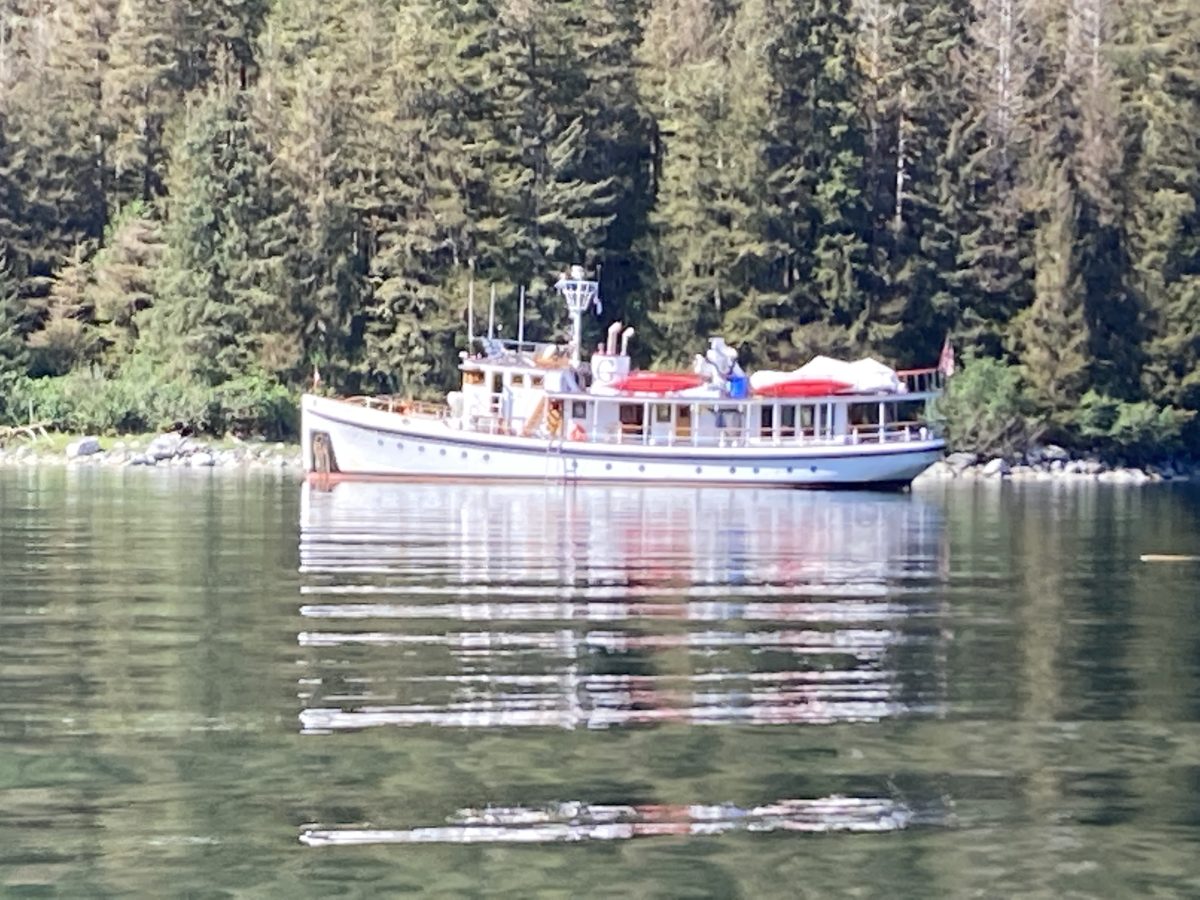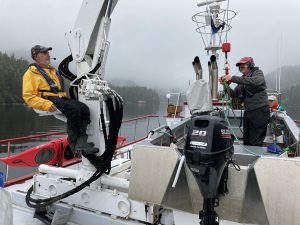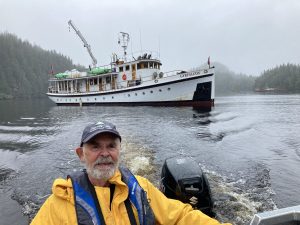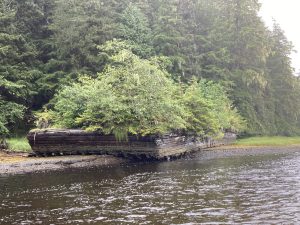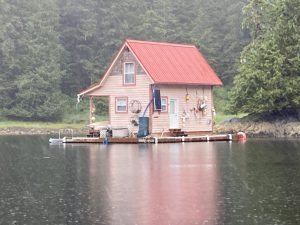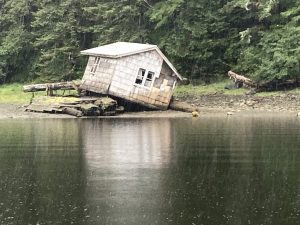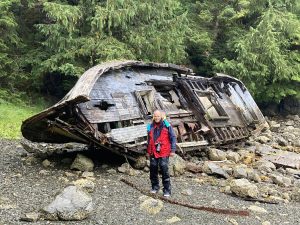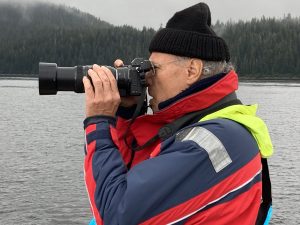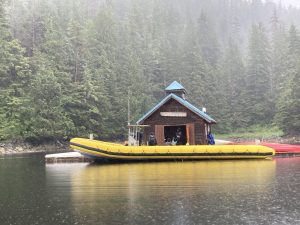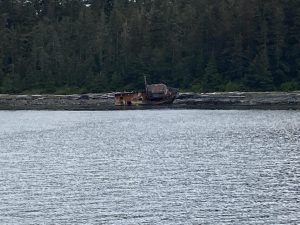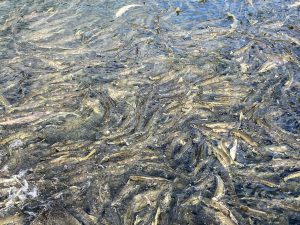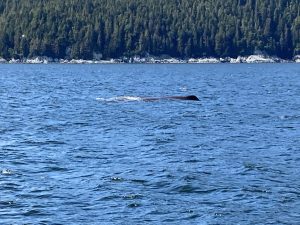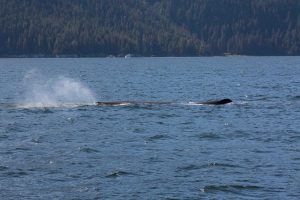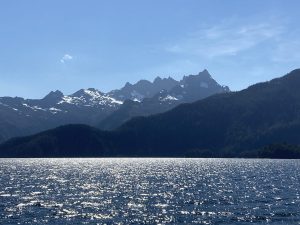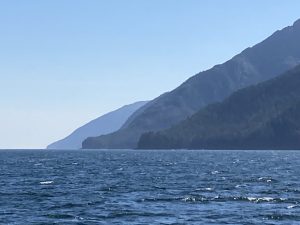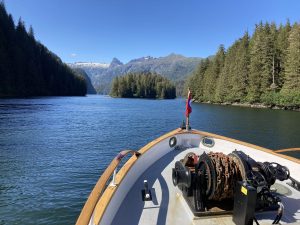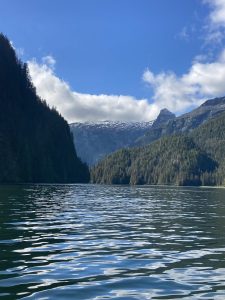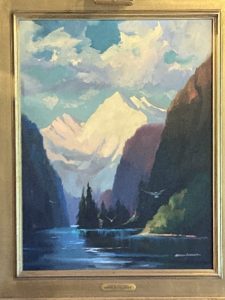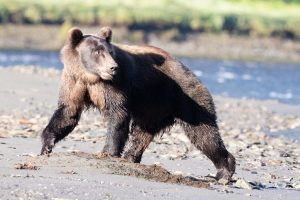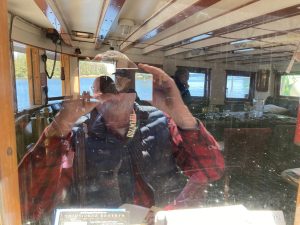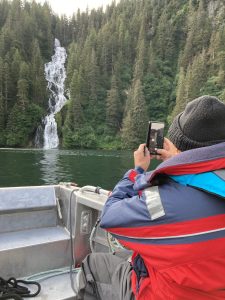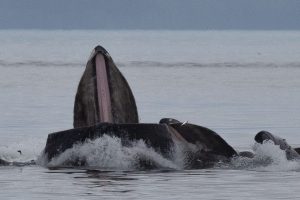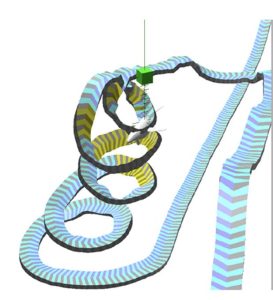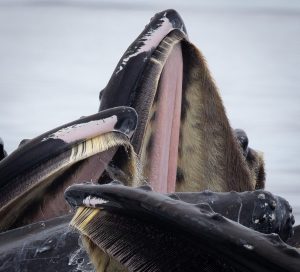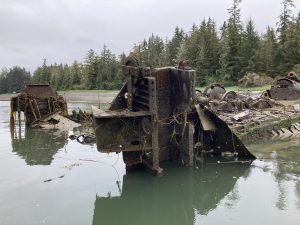A friend near Rome, Stefano Benazzo, has written four books on shipwrecks on this planet and wants to write a fifth about Alaska’s wrecks. This is not an easy task as just the SE panhandle of Alaska has as much coastline as all of Italy. During my last trip to Seattle, I ran into another acquaintance that I met at the Victoria Classic Boat Show a few years back; Nancy Everds, skipper of the Gyrfalcon and her husband, Peter Mann, who describes himself as Chief Engineer of Everything Else. And he also bakes bread. They are idled for the summer and decide to hang in Sitka taking life at a slower pace. What could be slower than teaming up with me! They agree to transport Stefano and myself on a week-long wreck hunt from Sitka to Petersburg–about 200 miles of coastline. In turn, they will have an Italian villa to stay in on their next visit to Europe. I play the guide after an overnight ferry ride to Sitka from Petersburg. Fog & rain all the way. During this week, we discover 27 wrecks! Read on.
Chief Engineer Mann commands the crane–Katahdin now needs one of these! This crane folds out from a matchbox and gently delivers the launch to the water. I’ve got crane envy now. We are anchored in Camp Coogan Bay a few miles south of Sitka where there lies a beached barge or two.
Off we go to the head of the Bay where there are two barges. A steel one on the west end and a century old wooden one on the east.
Here’s the wooden one–delivering Xmas trees before it went ashore. Chum Salmon flood the creek under our boat.
In adjacent Birdsnest Bay, there are a couple float houses. We stop at one and ask permission to visit an old wreck behind on the shore
The history and condition of these old stranded wrecks is Stefano’s passion. He has photographed almost 500 wrecks around the world from South Georgia Island to Iceland. Stefano maintains a website of his wrecks at stefanobenazzo.it. Stefano is retired from the Italian Foreign Service/Diplomatic Corps and spent many years in Moscow, Washington DC and Berlin and was Ambassador to Belarus and Bulgaria. He speaks about 5 or 6 languages. We talk politics and toss Russian phrases back & forth. If you understand Italian, here is an interview with Stefano. My kind of company!
We also notice this huge inflatable full of Cabella-clad “hunters” sporting assault rifles or similar designs. Testosterone poisoning or Second Amendment insecurity–not sure which. We exit Camp Coogan later in the day and anchor for the night in Promisla Bay where the nearby wreck of the 106′ tug Menoquet went down in the late 1970s. We visit the Menoquet the next morning and still arrive at Sergius Narrows an hour early–so stop in Salisbury Sound and fish for an hour–netting three nice salmon–our dinner in Rodman Bay in Peril Strait. Rodman Bay is noted for good crabbing and indeed, Peter and Stefano pull up three nice ones–one an incredible 9″ wide! We put the salmon on hold and have crab-cakes for dinner.
We leave Rodman Bay and are surprised by a wreck right on the NE tip of Catherine Island–on the entrance of Chatham Strait. I anchored there in 2003 enroute to Petersburg for a haul-out of the Katahdin. We had three days of hellacious weather with 35 knot winds on our nose–it took us nearly a week to get to Petersburg. Hunkered down on this bight, we saw brown bears within 20′ of our skiff.
Today, this same location is graced with this old steel wreck driven high on the beach by treacherous northerly winds. Not for the timid! We continue on to “L” Harbor and then take the launch over to Hidden Falls Hatchery the next morning where Chum Salmon swarm in to spawn.
South of “L” Harbor we encounter this whale–which I believe to be a Sperm Whale. These are returning to Alaskan waters and are a rare site to see. Their back is more straight and the blow is leftward. Nancy takes a better photo here:
The blow is towards the camera. We notify the nearby Fish & Wildlife Service vessel Kestrel by radio as this is a rare sighting.
Our next two nights are spent in Red Bluffs Inlet–which needs no introduction to locals here–sandwiched beyond the dark foreground ridge. Spectacular vertical cliffs greet the boater with two narrow entrances guarding the inner inlet. SE Alaska’s highest waterfalls is also there. We find three other boats there, including a New Zealand couple who are making their way around the world.
The headlands south to Port Alexander at the southern tip of Baranoff Island are nothing short of impressive. If one continues on this compass course, you’ll hit Antarctica some 9000 miles distant. Storms plunder this coastline and continue another 180 miles north to Haines; the longest “fjord” in the world. Alaskan politicians want to log it and build roads all the way to Skagway. Our ferry system works just fine. You need a solid boat here and the ferry fleet is now 60 years old. I’ve driven my 1899 tug, Katahdin up and down these waterways for 15 years–maintenance is the key.
The entrance to Red Bluff–named for the reddish bluffs on our starboard side.
And the second “entrance.” Several thread-like waterfalls tumble from the alpine zone above. This entrance reminds me of a painting hanging in my home by Merlin Ebnabnit, who taught art at Ohio State and was pals with Eustice Ziegler, one of the “Alaska Four ” artists. These four are Sydney Laurance, Eustace Ziegler, Jules Dahlager, and Ted Lambert. I would add two more: Fred Machetanz, and Magnus Colcord “Rusty” Heurlin.
Admiralty Island boasts the largest population of brown bears in Alaska and the world. Baranof and Chichagof Islands are also populated with these bruins. On Kodiak, biologists have classified the largest of these bears as a separate species.
At the head of Red Bluff, we spot a two year old brown bear–captured in pixels by Captain Nancy Evards and her 500mm lens.
With all of Stefano’s professional cameras and lenses and the skipper’s 500mm monster, I leave my Nikon system home and rely on my good old iPhone for photos. Here I immortalize our crew–Nancy and Peter at the helm–and Stefano (above the reflection of my left wrist) in the Gyrfalcon’s wheelhouse. I mar the photo with my reflection–but capture all four of us.
Stefano photographs the largest waterfall in SE. I think this distinction is that it plunges directly into the ocean, as many larger wisps of water can be seen tumbling down the alpine faces at many hundreds, if not thousands, of feet.
At the foot of Stevens Passage where it meets Frederick Sound (south of Five Fingers Lighthouse) one always is greeted by Humpback Whales bubble feeding. This suite of photos was also taken by Captain Nancy Evards. Three small fish try to escape these sieve-like baleen lined mouths. Perhaps a dozen whales cooperate by blowing a curtain of bubbles, trapping their prey. Here is a diagram of their pathway to the surface–published in a great article by Wiley, et al. I cannot link this article but here is one of the graphics (with permission).
Truly amazing to watch. Perhaps a dozen humpbacks participate in unison.
It is 25 miles back to Petersburg…..
……and to more wrecks for Stefano’s camera. Nine miles south of my cabin in Kupreanof, we spot this old steam pile-driver/barge; beached for dozens of years. 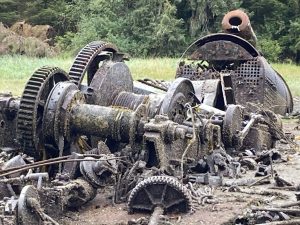
We’ve located about 6 wrecks within 10 miles of my house–a fact I did not appreciate until this trip. After another 10 days at the mythical South Kupreanof Yacht Club, Stefano departs for home to write his book, and plan another return visit–there are many more wrecks waiting. Gyrfalcon heads south for the winter–August storms can slow this return as they did during my retreat in 2018 with Katahdin. Stay tuned!

